2014 BMW 6 SERIES GRAN COUPE wheel size
[x] Cancel search: wheel sizePage 205 of 253
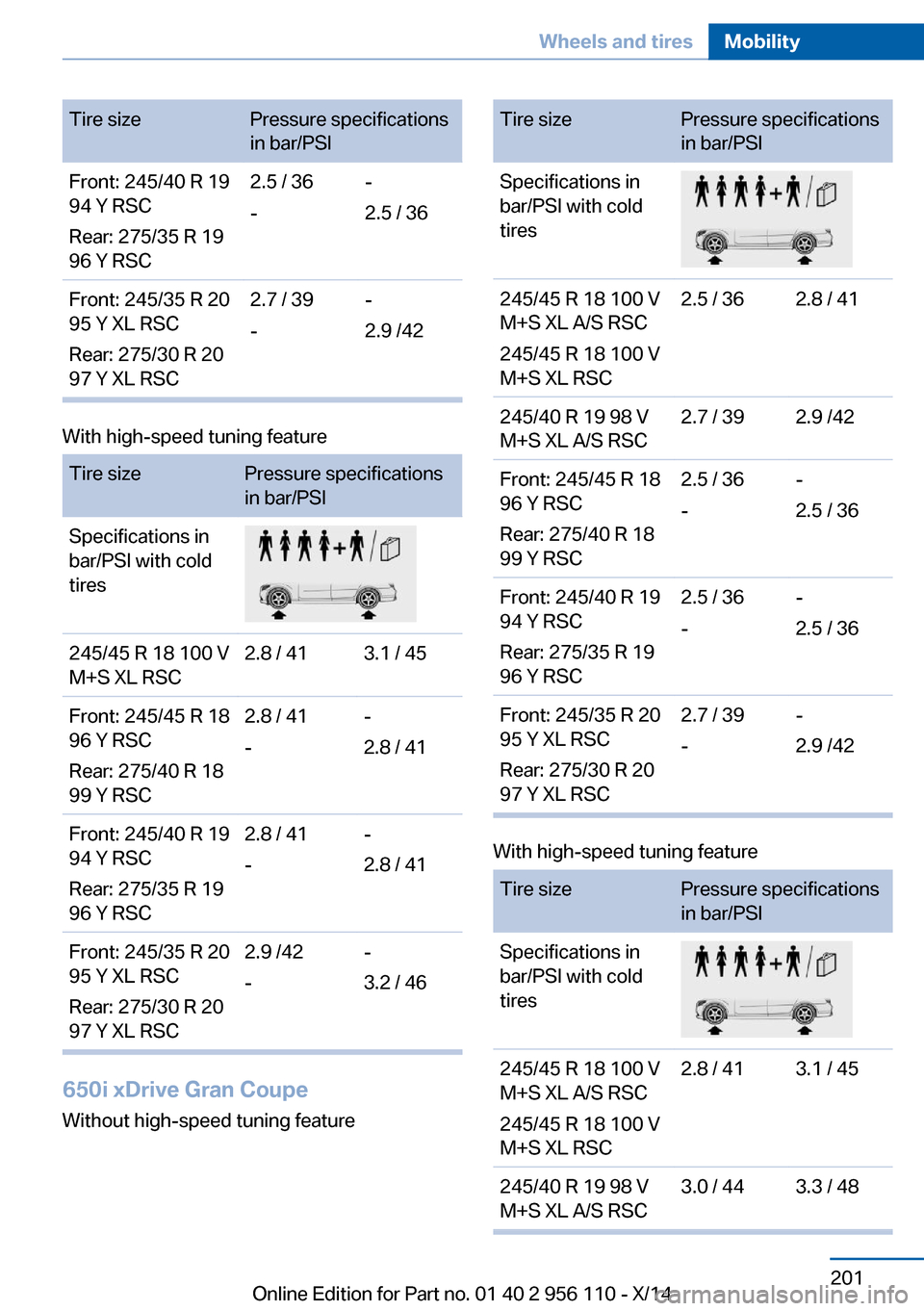
Tire sizePressure specifications
in bar/PSIFront: 245/40 R 19
94 Y RSC
Rear: 275/35 R 19
96 Y RSC2.5 / 36
--
2.5 / 36Front: 245/35 R 20
95 Y XL RSC
Rear: 275/30 R 20
97 Y XL RSC2.7 / 39
--
2.9 /42
With high-speed tuning feature
Tire sizePressure specifications
in bar/PSISpecifications in
bar/PSI with cold
tires245/45 R 18 100 V
M+S XL RSC2.8 / 413.1 / 45Front: 245/45 R 18
96 Y RSC
Rear: 275/40 R 18
99 Y RSC2.8 / 41
--
2.8 / 41Front: 245/40 R 19
94 Y RSC
Rear: 275/35 R 19
96 Y RSC2.8 / 41
--
2.8 / 41Front: 245/35 R 20
95 Y XL RSC
Rear: 275/30 R 20
97 Y XL RSC2.9 /42
--
3.2 / 46
650i xDrive Gran Coupe
Without high-speed tuning feature
Tire sizePressure specifications
in bar/PSISpecifications in
bar/PSI with cold
tires245/45 R 18 100 V
M+S XL A/S RSC
245/45 R 18 100 V
M+S XL RSC2.5 / 362.8 / 41245/40 R 19 98 V
M+S XL A/S RSC2.7 / 392.9 /42Front: 245/45 R 18
96 Y RSC
Rear: 275/40 R 18
99 Y RSC2.5 / 36
--
2.5 / 36Front: 245/40 R 19
94 Y RSC
Rear: 275/35 R 19
96 Y RSC2.5 / 36
--
2.5 / 36Front: 245/35 R 20
95 Y XL RSC
Rear: 275/30 R 20
97 Y XL RSC2.7 / 39
--
2.9 /42
With high-speed tuning feature
Tire sizePressure specifications
in bar/PSISpecifications in
bar/PSI with cold
tires245/45 R 18 100 V
M+S XL A/S RSC
245/45 R 18 100 V
M+S XL RSC2.8 / 413.1 / 45245/40 R 19 98 V
M+S XL A/S RSC3.0 / 443.3 / 48Seite 201Wheels and tiresMobility201
Online Edition for Part no. 01 40 2 956 110 - X/14
Page 206 of 253
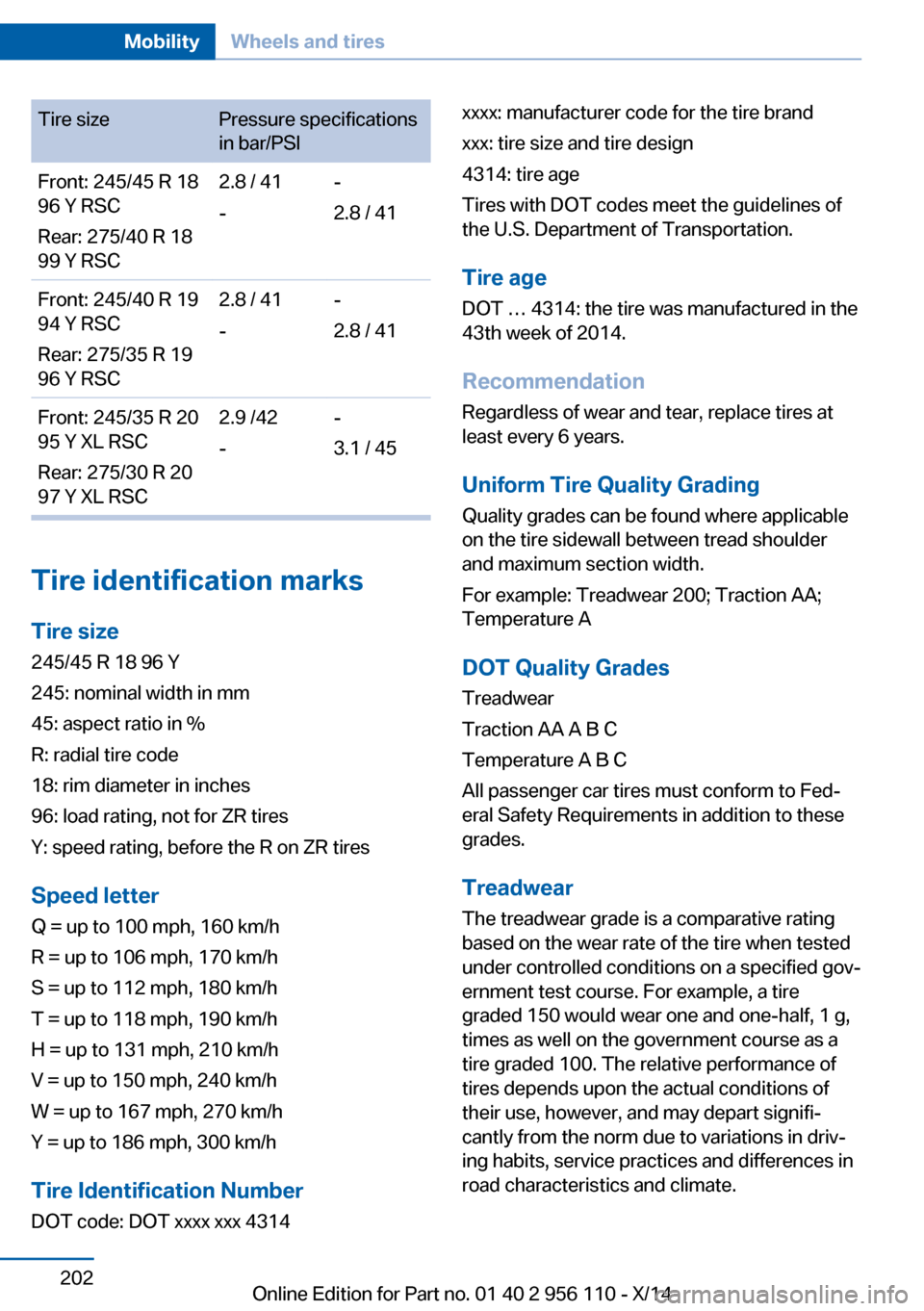
Tire sizePressure specifications
in bar/PSIFront: 245/45 R 18
96 Y RSC
Rear: 275/40 R 18
99 Y RSC2.8 / 41
--
2.8 / 41Front: 245/40 R 19
94 Y RSC
Rear: 275/35 R 19
96 Y RSC2.8 / 41
--
2.8 / 41Front: 245/35 R 20
95 Y XL RSC
Rear: 275/30 R 20
97 Y XL RSC2.9 /42
--
3.1 / 45
Tire identification marks
Tire size 245/45 R 18 96 Y
245: nominal width in mm
45: aspect ratio in %
R: radial tire code
18: rim diameter in inches
96: load rating, not for ZR tires
Y: speed rating, before the R on ZR tires
Speed letter
Q = up to 100 mph, 160 km/h
R = up to 106 mph, 170 km/h
S = up to 112 mph, 180 km/h
T = up to 118 mph, 190 km/h
H = up to 131 mph, 210 km/h
V = up to 150 mph, 240 km/h
W = up to 167 mph, 270 km/h
Y = up to 186 mph, 300 km/h
Tire Identification Number
DOT code: DOT xxxx xxx 4314
xxxx: manufacturer code for the tire brand
xxx: tire size and tire design
4314: tire age
Tires with DOT codes meet the guidelines of
the U.S. Department of Transportation.
Tire age
DOT … 4314: the tire was manufactured in the
43th week of 2014.
Recommendation
Regardless of wear and tear, replace tires at least every 6 years.
Uniform Tire Quality Grading Quality grades can be found where applicable
on the tire sidewall between tread shoulder
and maximum section width.
For example: Treadwear 200; Traction AA;
Temperature A
DOT Quality Grades
Treadwear
Traction AA A B C
Temperature A B C
All passenger car tires must conform to Fed‐
eral Safety Requirements in addition to these
grades.
TreadwearThe treadwear grade is a comparative rating
based on the wear rate of the tire when tested
under controlled conditions on a specified gov‐
ernment test course. For example, a tire graded 150 would wear one and one-half, 1 g,
times as well on the government course as a
tire graded 100. The relative performance of
tires depends upon the actual conditions of
their use, however, and may depart signifi‐
cantly from the norm due to variations in driv‐
ing habits, service practices and differences in
road characteristics and climate.Seite 202MobilityWheels and tires202
Online Edition for Part no. 01 40 2 956 110 - X/14
Page 208 of 253
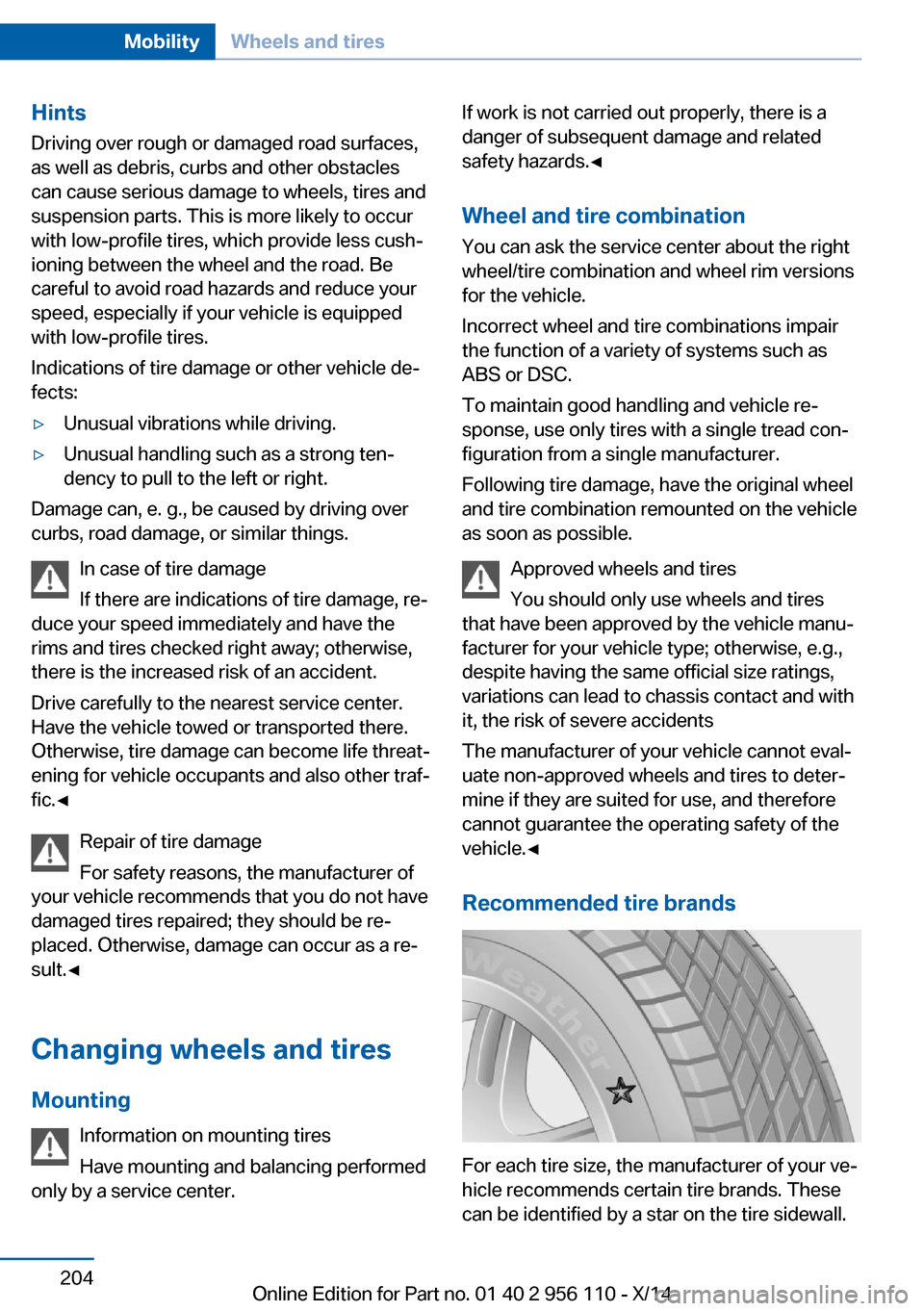
Hints
Driving over rough or damaged road surfaces,
as well as debris, curbs and other obstacles can cause serious damage to wheels, tires and
suspension parts. This is more likely to occur
with low-profile tires, which provide less cush‐
ioning between the wheel and the road. Be
careful to avoid road hazards and reduce your
speed, especially if your vehicle is equipped
with low-profile tires.
Indications of tire damage or other vehicle de‐
fects:▷Unusual vibrations while driving.▷Unusual handling such as a strong ten‐
dency to pull to the left or right.
Damage can, e. g., be caused by driving over
curbs, road damage, or similar things.
In case of tire damage
If there are indications of tire damage, re‐
duce your speed immediately and have the
rims and tires checked right away; otherwise,
there is the increased risk of an accident.
Drive carefully to the nearest service center.
Have the vehicle towed or transported there.
Otherwise, tire damage can become life threat‐
ening for vehicle occupants and also other traf‐
fic.◀
Repair of tire damage
For safety reasons, the manufacturer of
your vehicle recommends that you do not have
damaged tires repaired; they should be re‐
placed. Otherwise, damage can occur as a re‐
sult.◀
Changing wheels and tires
Mounting Information on mounting tires
Have mounting and balancing performed
only by a service center.
If work is not carried out properly, there is a
danger of subsequent damage and related
safety hazards.◀
Wheel and tire combination
You can ask the service center about the right
wheel/tire combination and wheel rim versions
for the vehicle.
Incorrect wheel and tire combinations impair
the function of a variety of systems such as
ABS or DSC.
To maintain good handling and vehicle re‐
sponse, use only tires with a single tread con‐
figuration from a single manufacturer.
Following tire damage, have the original wheel
and tire combination remounted on the vehicle
as soon as possible.
Approved wheels and tires
You should only use wheels and tires
that have been approved by the vehicle manu‐
facturer for your vehicle type; otherwise, e.g.,
despite having the same official size ratings,
variations can lead to chassis contact and with
it, the risk of severe accidents
The manufacturer of your vehicle cannot eval‐
uate non-approved wheels and tires to deter‐
mine if they are suited for use, and therefore
cannot guarantee the operating safety of the
vehicle.◀
Recommended tire brands
For each tire size, the manufacturer of your ve‐
hicle recommends certain tire brands. These
can be identified by a star on the tire sidewall.
Seite 204MobilityWheels and tires204
Online Edition for Part no. 01 40 2 956 110 - X/14
Page 209 of 253
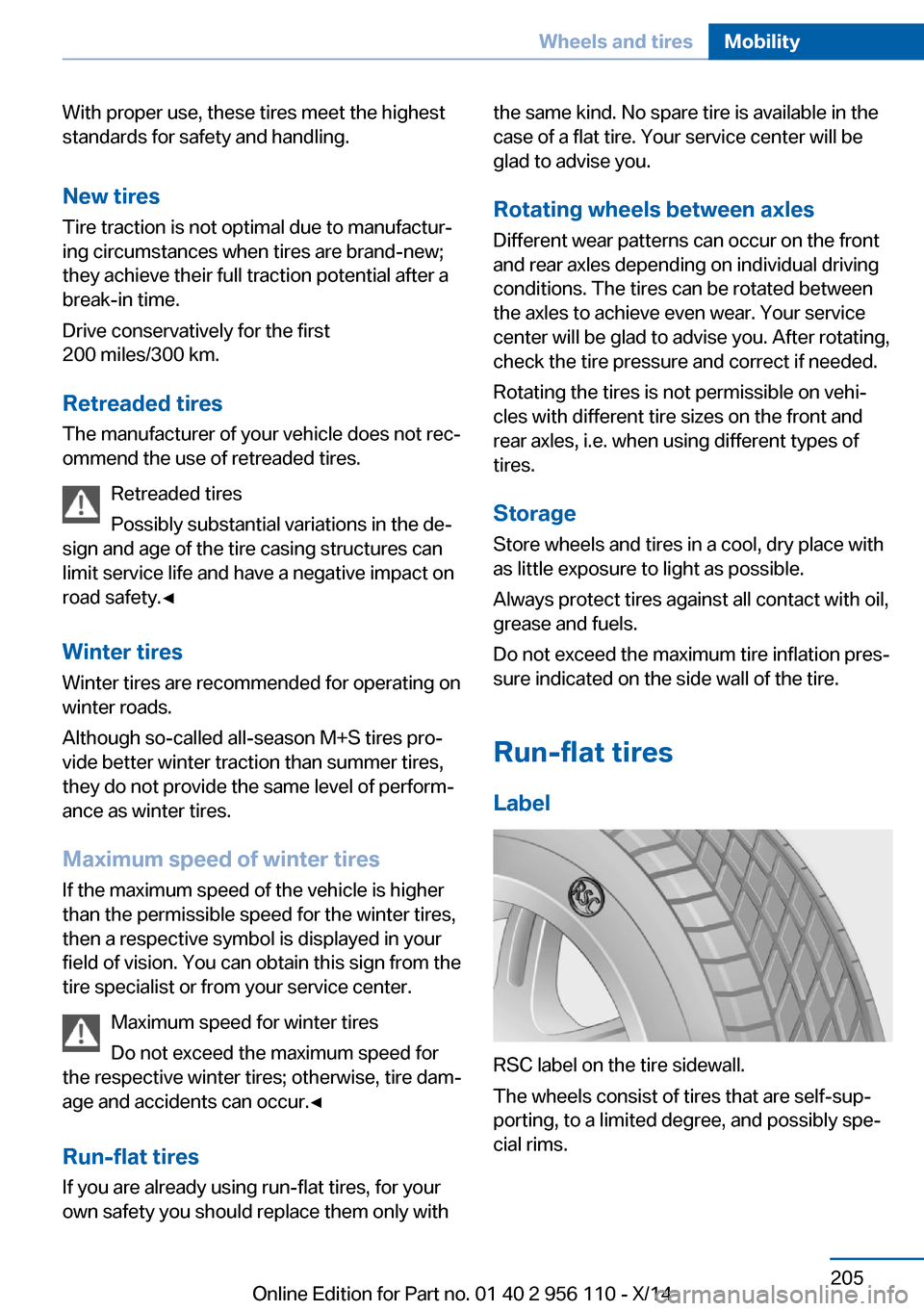
With proper use, these tires meet the highest
standards for safety and handling.
New tires Tire traction is not optimal due to manufactur‐
ing circumstances when tires are brand-new;
they achieve their full traction potential after a
break-in time.
Drive conservatively for the first
200 miles/300 km.
Retreaded tires
The manufacturer of your vehicle does not rec‐
ommend the use of retreaded tires.
Retreaded tires
Possibly substantial variations in the de‐
sign and age of the tire casing structures can
limit service life and have a negative impact on
road safety.◀
Winter tires
Winter tires are recommended for operating on
winter roads.
Although so-called all-season M+S tires pro‐
vide better winter traction than summer tires,
they do not provide the same level of perform‐
ance as winter tires.
Maximum speed of winter tires
If the maximum speed of the vehicle is higher
than the permissible speed for the winter tires,
then a respective symbol is displayed in your
field of vision. You can obtain this sign from the
tire specialist or from your service center.
Maximum speed for winter tires
Do not exceed the maximum speed for
the respective winter tires; otherwise, tire dam‐
age and accidents can occur.◀
Run-flat tiresIf you are already using run-flat tires, for your
own safety you should replace them only withthe same kind. No spare tire is available in the
case of a flat tire. Your service center will be
glad to advise you.
Rotating wheels between axles Different wear patterns can occur on the front
and rear axles depending on individual driving
conditions. The tires can be rotated between
the axles to achieve even wear. Your service
center will be glad to advise you. After rotating,
check the tire pressure and correct if needed.
Rotating the tires is not permissible on vehi‐
cles with different tire sizes on the front and
rear axles, i.e. when using different types of
tires.
Storage Store wheels and tires in a cool, dry place with
as little exposure to light as possible.
Always protect tires against all contact with oil,
grease and fuels.
Do not exceed the maximum tire inflation pres‐
sure indicated on the side wall of the tire.
Run-flat tires Label
RSC label on the tire sidewall.
The wheels consist of tires that are self-sup‐
porting, to a limited degree, and possibly spe‐
cial rims.
Seite 205Wheels and tiresMobility205
Online Edition for Part no. 01 40 2 956 110 - X/14
Page 210 of 253
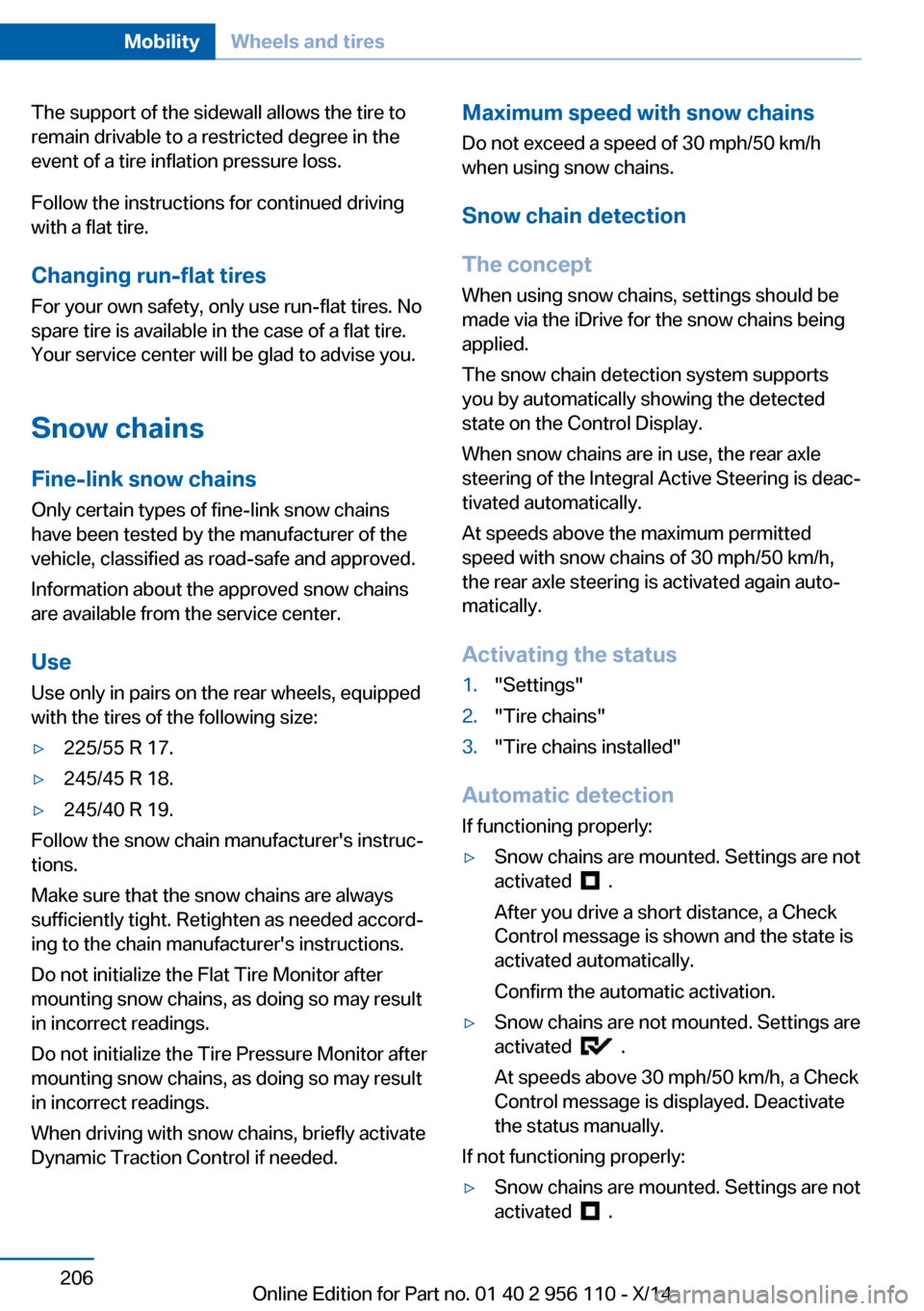
The support of the sidewall allows the tire to
remain drivable to a restricted degree in the
event of a tire inflation pressure loss.
Follow the instructions for continued driving
with a flat tire.
Changing run-flat tires
For your own safety, only use run-flat tires. No
spare tire is available in the case of a flat tire.
Your service center will be glad to advise you.
Snow chains
Fine-link snow chains
Only certain types of fine-link snow chains
have been tested by the manufacturer of the
vehicle, classified as road-safe and approved.
Information about the approved snow chains
are available from the service center.
Use
Use only in pairs on the rear wheels, equipped
with the tires of the following size:▷225/55 R 17.▷245/45 R 18.▷245/40 R 19.
Follow the snow chain manufacturer's instruc‐
tions.
Make sure that the snow chains are always
sufficiently tight. Retighten as needed accord‐
ing to the chain manufacturer's instructions.
Do not initialize the Flat Tire Monitor after
mounting snow chains, as doing so may result
in incorrect readings.
Do not initialize the Tire Pressure Monitor after
mounting snow chains, as doing so may result
in incorrect readings.
When driving with snow chains, briefly activate
Dynamic Traction Control if needed.
Maximum speed with snow chains
Do not exceed a speed of 30 mph/50 km/h
when using snow chains.
Snow chain detection
The concept
When using snow chains, settings should be
made via the iDrive for the snow chains being
applied.
The snow chain detection system supports
you by automatically showing the detected
state on the Control Display.
When snow chains are in use, the rear axle
steering of the Integral Active Steering is deac‐
tivated automatically.
At speeds above the maximum permitted
speed with snow chains of 30 mph/50 km/h,
the rear axle steering is activated again auto‐
matically.
Activating the status1."Settings"2."Tire chains"3."Tire chains installed"
Automatic detection If functioning properly:
▷Snow chains are mounted. Settings are not
activated
.
After you drive a short distance, a Check
Control message is shown and the state is
activated automatically.
Confirm the automatic activation.
▷Snow chains are not mounted. Settings are
activated
.
At speeds above 30 mph/50 km/h, a Check
Control message is displayed. Deactivate
the status manually.
If not functioning properly:
▷Snow chains are mounted. Settings are not
activated
.
Seite 206MobilityWheels and tires206
Online Edition for Part no. 01 40 2 956 110 - X/14
Page 249 of 253
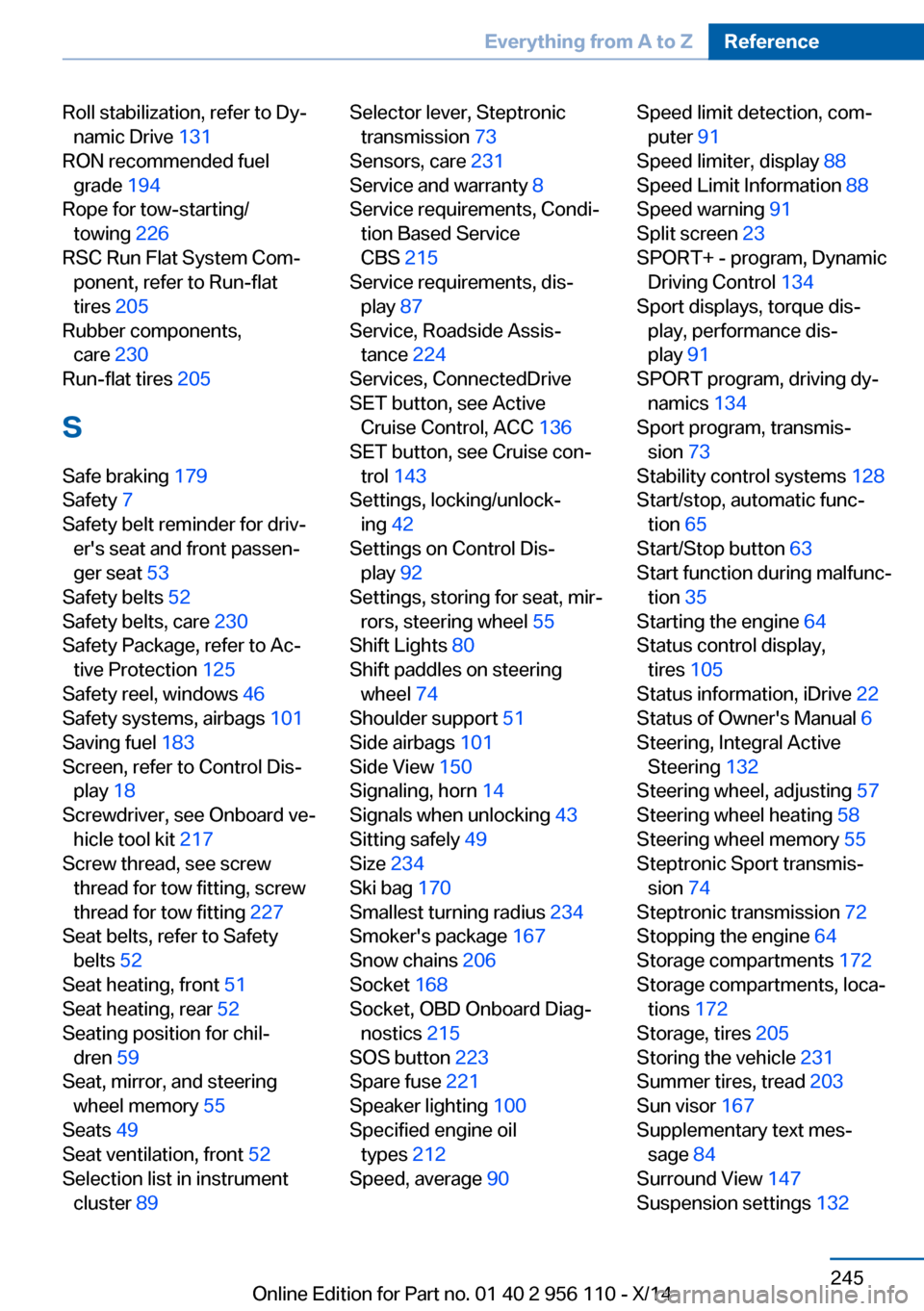
Roll stabilization, refer to Dy‐namic Drive 131
RON recommended fuel grade 194
Rope for tow-starting/ towing 226
RSC Run Flat System Com‐ ponent, refer to Run-flat
tires 205
Rubber components, care 230
Run-flat tires 205
S Safe braking 179
Safety 7
Safety belt reminder for driv‐ er's seat and front passen‐
ger seat 53
Safety belts 52
Safety belts, care 230
Safety Package, refer to Ac‐ tive Protection 125
Safety reel, windows 46
Safety systems, airbags 101
Saving fuel 183
Screen, refer to Control Dis‐ play 18
Screwdriver, see Onboard ve‐ hicle tool kit 217
Screw thread, see screw thread for tow fitting, screw
thread for tow fitting 227
Seat belts, refer to Safety belts 52
Seat heating, front 51
Seat heating, rear 52
Seating position for chil‐ dren 59
Seat, mirror, and steering wheel memory 55
Seats 49
Seat ventilation, front 52
Selection list in instrument cluster 89 Selector lever, Steptronic
transmission 73
Sensors, care 231
Service and warranty 8
Service requirements, Condi‐ tion Based Service
CBS 215
Service requirements, dis‐ play 87
Service, Roadside Assis‐ tance 224
Services, ConnectedDrive
SET button, see Active Cruise Control, ACC 136
SET button, see Cruise con‐ trol 143
Settings, locking/unlock‐ ing 42
Settings on Control Dis‐ play 92
Settings, storing for seat, mir‐ rors, steering wheel 55
Shift Lights 80
Shift paddles on steering wheel 74
Shoulder support 51
Side airbags 101
Side View 150
Signaling, horn 14
Signals when unlocking 43
Sitting safely 49
Size 234
Ski bag 170
Smallest turning radius 234
Smoker's package 167
Snow chains 206
Socket 168
Socket, OBD Onboard Diag‐ nostics 215
SOS button 223
Spare fuse 221
Speaker lighting 100
Specified engine oil types 212
Speed, average 90 Speed limit detection, com‐
puter 91
Speed limiter, display 88
Speed Limit Information 88
Speed warning 91
Split screen 23
SPORT+ - program, Dynamic Driving Control 134
Sport displays, torque dis‐ play, performance dis‐
play 91
SPORT program, driving dy‐ namics 134
Sport program, transmis‐ sion 73
Stability control systems 128
Start/stop, automatic func‐ tion 65
Start/Stop button 63
Start function during malfunc‐ tion 35
Starting the engine 64
Status control display, tires 105
Status information, iDrive 22
Status of Owner's Manual 6
Steering, Integral Active Steering 132
Steering wheel, adjusting 57
Steering wheel heating 58
Steering wheel memory 55
Steptronic Sport transmis‐ sion 74
Steptronic transmission 72
Stopping the engine 64
Storage compartments 172
Storage compartments, loca‐ tions 172
Storage, tires 205
Storing the vehicle 231
Summer tires, tread 203
Sun visor 167
Supplementary text mes‐ sage 84
Surround View 147
Suspension settings 132 Seite 245Everything from A to ZReference245
Online Edition for Part no. 01 40 2 956 110 - X/14